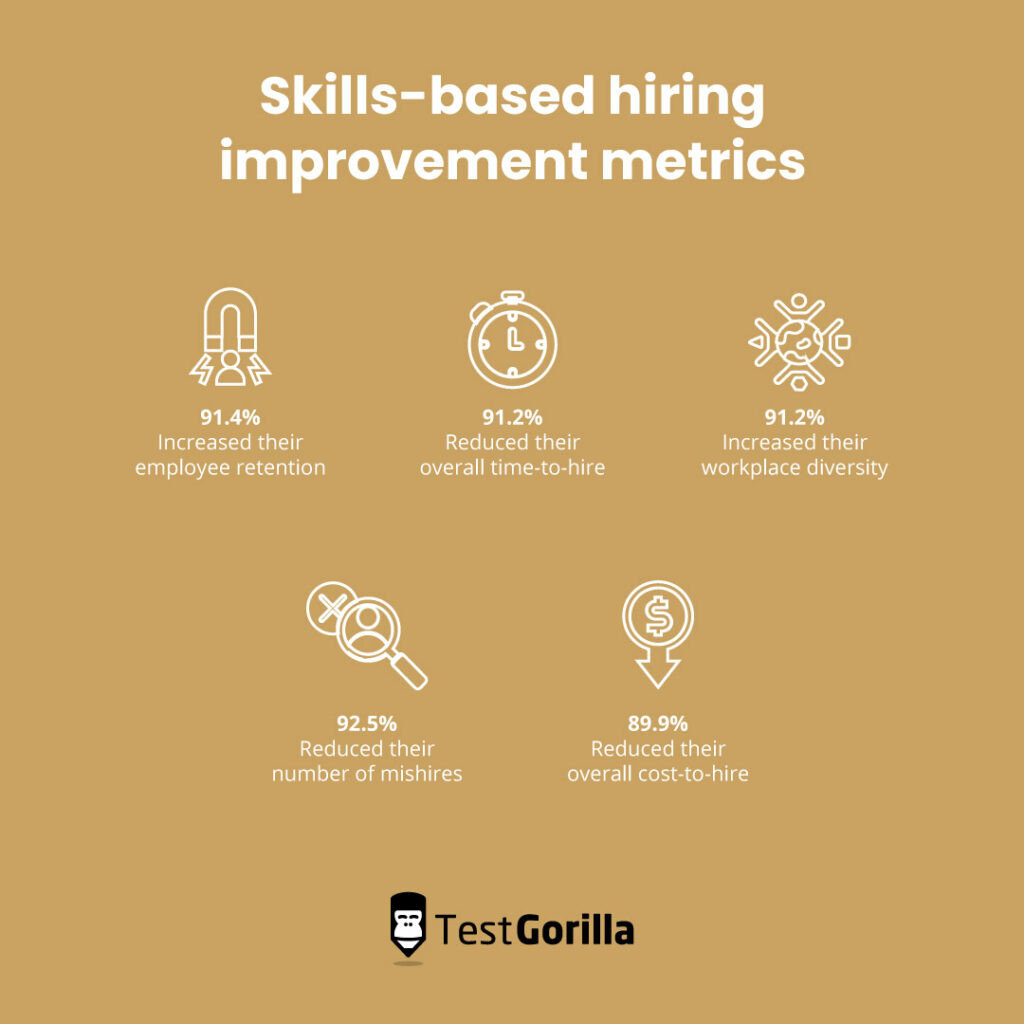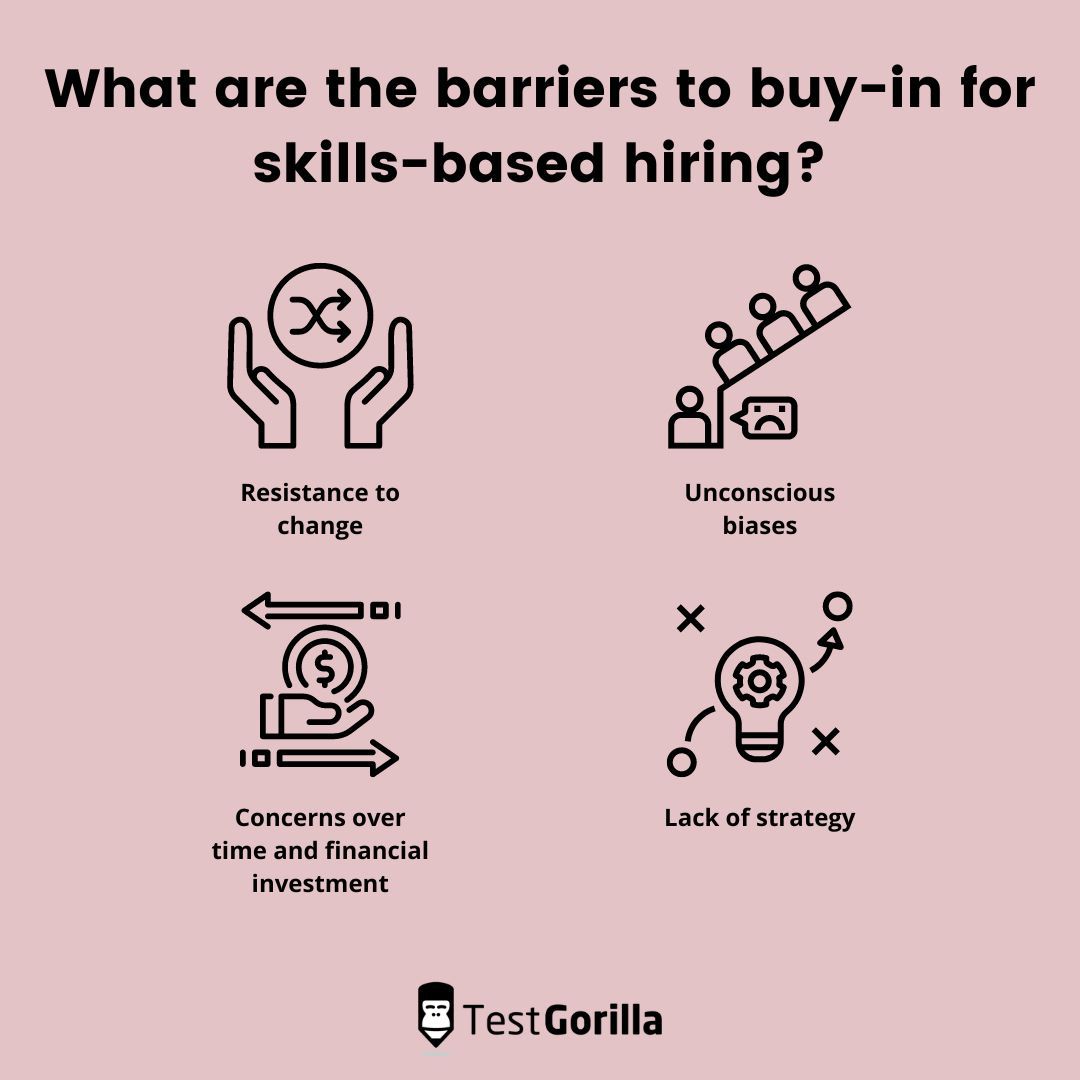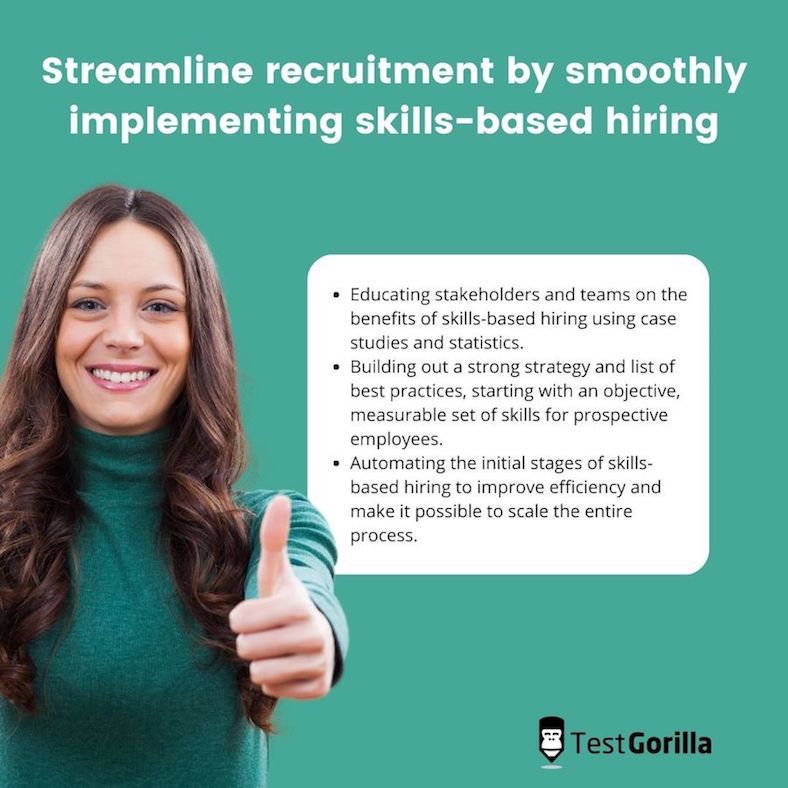Making the case for skills-based hiring: How to get buy-in from stakeholders
From reduced hiring costs to decreased time-to-hire, skills-based hiring provides a number of significant benefits to organizations. However, it can still be hard to get buy-in on these practices.
Stakeholders and hiring managers may be unsure how to implement new hiring methods and worry that it will cost too much time and money. There’s also a reluctance to change because of a lack of understanding on the limits of resumes, a business-as-usual approach to hiring, and a reliance on old networks for sourcing talent.
But you can make people aware of the problem through training. By creating a clear strategy and pointing to the benefits of skills-based hiring, you can show them a better way. With education, they’ll understand how they can actually save money and time on recruitment in the long run through a data-driven approach.
In this article, we explore how you can make the transition to skills-based hiring easier by getting buy-in through training, education, and documentation.
What are the benefits of skills-based hiring?
Skills-based hiring can drastically reduce the amount it costs to hire a new employee. Not only does it eliminate overheads (such as external recruiters and resume screening software), but it pinpoints candidates who are a better fit more quickly.
By sending candidates a link to skills-based tests before the interview stage, recruiters can receive objective data about how well a candidate would do in a particular role. And automating this process means they can screen high numbers of candidates in minutes.
According to our recent report on the State of Skills-based Hiring in 2022, 92.5% of companies have seen a reduction in mis-hires when skills-based hiring is deployed. And 91.4% reported a reduction in the amount of time between a candidate applying and them accepting a job offer.
A majority of employers also reported reducing their cost-to-hire with skills-based hiringSource: State of Skills-Based Hiring 2022
The cultural benefits of skills-based hiring are equally significant. With this approach, you can reduce the bias found in resume-based recruitment methods and create a more diverse workforce. While CV software might reject recent graduates because they have only a few years of experience, a skills-based approach helps you avoid snap judgments that might rule out interesting candidates from diverse and non-traditional backgrounds.
Taking a skills-based approach goes beyond hiring too. By focusing on skills right from the start, you can build an awareness of gaps and identify existing employees for upskilling or reskilling. This has a beneficial effect on employee engagement as well as operational efficiency, as people feel invested in companies that care about their futures.
What are the barriers to buy-in for skills-based hiring?
Despite the benefits, it can be difficult to get an entire organization to invest in skills-based hiring. Industries that are very knowledge-intensive, like IT or pharmaceuticals, have been quicker to adopt these practices because they recognize the urgency of plugging skill gaps.
In this section, we explore some of the reasons why other industries are falling behind.
Resistance to change
Attachment to traditional recruitment practices can hold companies back. Cengage Group CEO, Michael Hansen gives an example: “Employers seem to be stuck in a contradictory cycle, where they recognize that a degree is not an indicator of job readiness, but nonetheless require them as part of their candidate screening process.”
Not understanding what the alternatives are or not knowing the benefits of skills-based hiring means that employers are likely to stick to more traditional recruitment methods.
Unconscious biases
Any form of recruitment that contains demographic data (such as names or gender) is subject to unconscious bias. This is shown in Implicit Association Tests in which people’s associations with different concepts are assessed in order to reveal subconscious leanings.
For example, a person might believe that men and women are equally skilled at math and art, but be quicker to link art with women and math with men in an IAT. Data collected from Harvard showed that 70% of white respondents who reported themselves as not being racist displayed at least some white preference in their answers.
More consciously, some people may cling to the idea that employees need a certain amount of experience or a particular degree to do well in a role. Or they may judge resumes based on linguistic ability even where this isn’t a skill that pertains to the role.
Many stakeholders and hiring managers are unaware of these preconceptions and therefore don’t realize great candidates are being overlooked. They promote resume-based hiring because they’re unaware that it can lead to unintentional discrimination.
Concerns over time and financial investment
Skills-based hiring requires the addition of an extra step between receiving a candidate’s application and inviting them to interview. In our report, 38.2% of hiring managers were concerned that adding skills-based tests could slow down the recruitment process and mean missing out on great candidates.
The expenses involved with filling a role can be upwards of three times a person’s salary. And it’s understandable that stakeholders don’t want to make this figure even higher. With a high upfront outlay and a lack of understanding about savings down the line, they may be reluctant to pay anything before they have paid team members to spend time sifting through candidates.
For many, there’s also a concern that they will have to hire external consultants or companies to do skills-based hiring for them. Some hiring managers feel that they don’t have the internal resources to take on all of the admin involved, from creating the tests to scoring the results. And they worry about making mistakes with a new process, costing themselves even more time and money.
Lack of strategy
Many employees understand the benefits of skills-based hiring but lack an understanding of how to implement it. They may have concerns about how to:
Create reliable tests
Assess industry-specific skills
Assess soft skills
Assess culture fit
Manage the volume of applications
Avoid cheating in tests
Streamline the entire process
What’s more, a recent McKinsey study showed that one of employers’ top three concerns when implementing skills-based hiring is scaling their systems. While they may be able to create reliable tests for a small number of people, manually sifting through hundreds of applications is not feasible.
In the next section, we’ll explore how companies can get buy-in by showing stakeholders and hiring managers how these processes can be automated.
The best insights on HR and recruitment, delivered to your inbox.
Biweekly updates. No spam. Unsubscribe any time.
Getting stakeholder and team buy-in
Now that we’ve had a look at the reasons why some people are resistant to skills-based hiring, we’ll explore how HR departments and recruiters can help stakeholders to identify and overcome their resistance to change and transition to this model.
Educate team and stakeholders on the significance of skills-based hiring
Members of the Accenture business accelerator program pointed to internal education and consensus building as top priorities when implementing skills-based hiring. Showing team members the benefits in real-world situations allows you to initiate action.
Point out to stakeholders that Revolut improved their time-to-hire by 40% using skills-based hiring, for example, and that Gardenvity reduced recruitment costs by 40%. Presenting case studies like this alongside statistics about skills-based hiring builds out a compelling case for stakeholders who are concerned about time investment and costs.
On the other hand, it’s equally important to educate people on the problems of resume-based hiring. This will make the transition from a familiar model feel easier to understand and more urgent.
These challenges include:
The number of inaccuracies on resumes. Over 32% of people admit to embellishing the truth on their CV. And even where people aren’t aware that they’re lying, there are likely to be inaccuracies because no one has a perfect memory.
The lack of insight into personality. It’s hard to gain true insight into character or culture add when reading an account of a person on a piece of paper. And even get to know questions like “what kind of activities energize you?” can be vague and difficult to answer.
They can introduce bias. AI-based resume-screening software may rule out people with gaps in their work history due to illness, for example. And any method that involves judging candidates on a limited view of their experience and qualifications can lead to unintentional discrimination.
Changing opinions of skills-based hiring also means proving to stakeholders that it doesn’t need to come with additional costs or time commitments. Explain that skills-based hiring is not an additional (costly) step in the traditional recruitment funnel, but a replacement for time-consuming traditional methods.
Invest in training
Even with education, stakeholders and hiring managers will likely not realize there’s an urgent issue with resume-based hiring if they haven’t addressed their unconscious biases. Diversity and inclusion training is essential to deconstructing these ideas, and changing company culture to one that works with skills-based practices.
As Matthew MacLachlan, the head of innovation at inclusion training platform Country Navigator, says: “At its heart, cultural intelligence is about learning about yourself and others in order to cooperate and collaborate more effectively… It’s about trying to get an unimpeded perspective on reality.”
The diversity and inclusion programs you implement should be:
Actionable. Without giving concrete tools to help people change their behaviors or attitudes, training merely draws attention to the problem.
Empathy-driven. Include and encourage interactions from different groups, and amplify voices of marginalized people.
Tracked. It’s important to measure the effectiveness of the training and to review and create all policies in this light.
Create well-documented processes
Implementing a well-thought-out strategy makes it easier for team members to adapt to a new, skills-based approach. And training everyone involved in hiring on best practices is key to empowering them to make decisions with the new process as a guide.
Need more guidance on implementing skills-based hiring?
Read our complete handbook for all the tips, tools, and strategies you need to get the most out of this transformational approach to recruitment.
Start by identifying and defining the specific, objective, and measurable skills required for each role. These skills should add value as opposed to just being preferred competencies. For instance, rather than looking for an “all-rounder” if you were advertising a marketing role, you may use a practical test to assess candidates’ experience with Google Ads or Adobe Photoshop. You should also be sure to include soft skills, such as communication or culture add.
Look at top performers to create this list of skills. A hiring manager for a sales team might find that top performers in their department are highly communicative, for example. Testing for written communication could then replace an arbitrary requirement like “must have 4 years of experience” in a resume-based hiring process. You can also test top performers to benchmark results for these skills tests, so you have an accurate standard to measure candidates against.
Ensure that you write descriptions that focus on the responsibilities of the role rather than personal requirements. This will help candidates to understand what is expected of them, and encourage people to apply who may not fit educational or work-history-based criteria.
Automate the initial stages
According to data from the Society for Human Resource Management (SHRM), the average cost per hire was nearly $4,700. But that just covers the HR cost, without taking into account the time departmental managers invest in supporting HR.
By showing stakeholders how much manual work they can save with skills-based hiring, the approach becomes a much more valuable proposition for hiring managers who can get back to their main tasks much faster.
Testing skills early in the recruitment process helps hiring managers make quicker decisions about a shortlist and saves them from manually checking take-home assignments.
And by using skills-based testing software, you improve efficiency and keep everything in-house – so you don’t need to pay for external advisors.
You can use your applicant tracking system (ATS) to send out automated emails to candidates containing a link to a skills test. Then, you can send one to the hiring manager which includes the test results of the highest-scoring candidates.
Through software, you can choose from a vast library of pre-built tests or create your own assessments. In one dashboard, you can see the top candidates ranked in order before you even think about interviews.
Streamline recruitment by smoothly implementing skills-based hiring
It’s not always easy to get stakeholders and hiring managers on board with skills-based hiring. They often don’t understand the limits of resumes and continue with their usual hiring practices, relying on old networks (like particular universities) to find talent.
In addition, they don’t realize what alternatives exist and have concerns over time and monetary investment.
Between sifting through dozens of candidates at the interview stage and missing out on others due to biases, resume-based recruitment is more time-consuming in the long run. It’s also often unfair to candidates.
Moving to a skills-based model means drawing the attention of stakeholders and teams to the flaws of resume-based hiring and encouraging them to be open to a better alternative.
Strategies through which you can do this include:
Educating stakeholders and teams on the benefits of skills-based hiring using case studies and statistics.
Building out a strong strategy and list of best practices, starting with an objective, measurable set of skills for prospective employees.
Automating the initial stages of skills-based hiring to improve efficiency and make it possible to scale the entire process.
By implementing a strategy that shows stakeholders that skills-based hiring doesn’t have to be expensive or complicated, you can get their buy-in and start recruiting in a fairer and more business-efficient way.
Want to reduce the time and costs associated with recruitment?
Understand the challenges of skill-based hiring to implement new strategies and boost hiring ROI.
Download the 2022 State of Skills-based Hiring report to learn more.
Related posts
You've scrolled this far
Why not try TestGorilla for free, and see what happens when you put skills first.






















